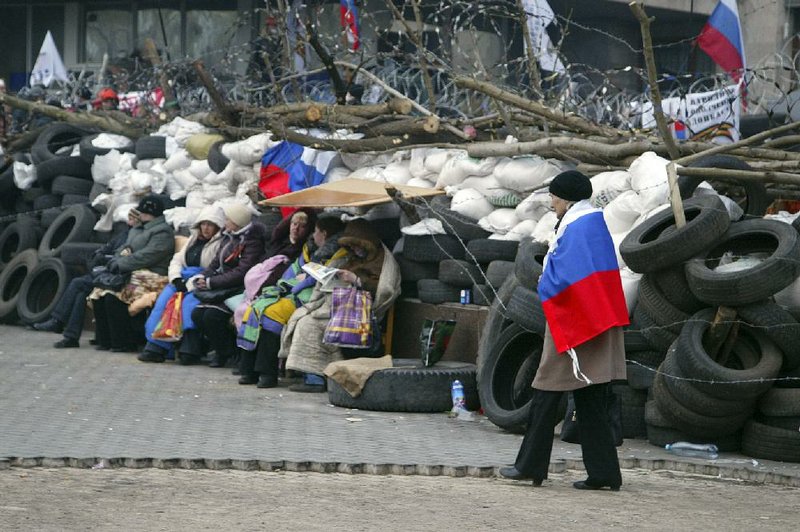MOSCOW - Russian President Vladimir Putin threatened Wednesday to demand advance payment from Ukraine for gas supplies, a move designed to exert economic pressure on the neighboring country.
Ukraine already faces possible bankruptcy, a mutiny by pro-Russian separatists in the east and a Russian military buildup across the border.
NATO’s top commander in Europe warned that the alliance could respond to the Russian military threat against Ukraine by deploying U.S. troops to eastern Europe, but Putin’s latest tactics suggest that he may be aiming to secure clout without invading.
Speaking at a Cabinet session, the Russian leader voiced hope that diplomatic efforts to ease the Ukrainian crisis will yield “positive results,” an apparent reference to talks set for next week that will feature the U.S., the European Union, Russia and Ukraine for the first time since the crisis began.
Russia wants the talks to focus on a road map for Ukraine that would include constitutional overhauls to turn it into a federation and guarantee its neutral status. Those demands reflect the Kremlin’s hope of retaining influence over its neighbor and ensuring that it’s too unorganized to join NATO or other blocs. Ukraine has responded by saying it will not be dictated by Russia.
Putin instructed his government to be prepared to charge Ukraine in advance for gas supplies. He said the change needed to be taken if “additional consultations” with the EU fail to yield results.
Russia has already eliminated a gas discount that it had given Ukraine, arguing that it was tied to a lease for Russia’s Black Sea Fleet base in Crimea, a Ukrainian region that Russia annexed last month. And Ukraine has promised the International Monetary Fund that it will cut energy subsidies to citizens in exchange for a bailout loan of up to $14 billion. With those two actions, gas prices were set to rise 50 percent on May 1.
The Kremlin pressure comes as pro-Russian protesters have continued to occupy government buildings in eastern Ukraine.
Ukrainian Interior Minister Arsen Avakov said the standoff in Luhansk and the two neighboring Russian-leaning regions of Donetsk and Kharkiv must be resolved within two days.
“I want to repeat that there are two options: political settlement through negotiations and the use of force,” Avakov told reporters. “We are ready for both options.”
Russian Foreign Minister Sergey Lavrov quickly responded by warning against “making 48-hour ultimatums.
“The situation can only be settled through an equal and respectful dialogue,” he said.
The cities affected by the uprisings are in Ukraine’s industrial Russian-speaking heartland in the east, which has a large population of ethnic Russians and strong economic and cultural ties to Russia. Many residents are suspicious of the government that took power in February after pro-Russian President Viktor Yanukovych fled the capital after months of protests.
While Putin kept a military option on the table, saying that “all means” could be used to protect Russian-speakers, Moscow appears concerned about the military, political and economic consequences of invading eastern Ukraine.
The West, which has slapped Putin’s entourage with travel bans and asset freezes in response to Russia’s annexation of Crimea, has said it will introduce far more painful sanctions against Russia’s energy industries and other economic sectors if Moscow sends troops into eastern Ukraine.
Unlike Crimea, which was quickly swept by Russian forces who met no resistance from Ukrainian troops, an invasion into the east is seen as likely to trigger extensive fighting.
From an economic viewpoint, taking control of a huge part of territory in the east, which accounts for nearly a quarter of Ukraine’s population of 46 million and the bulk of its industrial wealth, would require huge investments.
About 40,000 Russian troops deployed alongside the Ukrainian border, however, have underlined Russia’s readiness to act. Moscow rejected Western demands to pull them back, saying that it has the right to station the military wherever it wants in its territory.
An assortment of satellite images provided from NATO headquarters showed dozens of Russian tanks and other armored vehicles, combat jets and helicopter gunships stationed in areas along the Ukrainian border. But the photographs were not enough to judge the full scope of the deployment.
NATO’s top military commander in Europe, U.S. Air Force Gen. Philip Breedlove, said counter moves to the Russian military threat against Ukraine could include sending American troops to alliance nations in eastern Europe that feel at risk.
“Essentially what we are looking at is a package of land, air and maritime measures that would build assurance for our easternmost allies,” he said.
In Luhansk, masked protesters warned the government that any attempt to storm the headquarters of Ukraine’s Security Service, which they occupied, would be a “welcome to hell.” Hundreds of supporters camped outside the building overnight, shouting “Putin! Putin!” They erected high barricades along a thoroughfare running in front of the building.
In Donetsk, where protesters were occupying another government building, regional Gov. Serhiy Taruta met with key activists to negotiate a peaceful solution. Both he and the activists sounded optimistic after the talks.
“I’m sure that we will solve this peacefully,” Taruta said. “Any forceful measures will only aggravate the situation.” Information for this article was contributed by John-Thor Dahlburg, Maria Danilova, Laura Mills and Monika Scislowska of The Associated Press.
Front Section, Pages 6 on 04/10/2014


